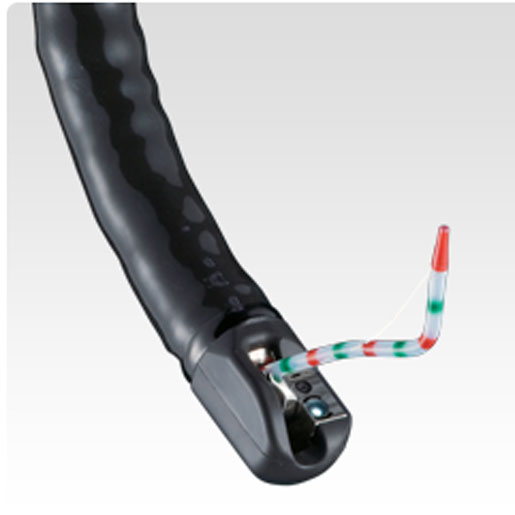Duodenoscope Maker Updates and Validates Reprocessing Protocol
FUJIFILM Medical Systems, USA, one of the three manufacturers selling duodenoscopes in the United States, has published revised, validated reprocessing instructions for one of its duodenoscope models.
December 28, 2015

Marie Thibault
FUJIFILM Medical Systems, USA has released revised reprocessing instructions for one of its duodenoscope models.
After a long year of negative headlines about duodenoscopes, one scope maker had an early holiday gift for its customers. FUJIFILM Medical Systems, USA (Fuji) sent a letter to customers last week detailing revised reprocessing instructions for one of its duodenoscope models as well as a box of new brushes to use with the protocol.
In a December 23 Safety Communication, FDA said it had reviewed and accepted Fuji's revised reprocessing instructions and validation data on its ED-530XT duodenoscope. The scope maker also offers other duodenoscope models, including the ED-250XL5, ED-250XT5, ED-450XL5, and ED-450XT5. These other scopes are undergoing validation testing but meanwhile, according to Fuji and FDA, the revised 530XT reprocessing instructions should be used to clean these scopes as well.
"FDA believes that the revised reprocessing instructions for the ED-530XT duodenoscope are more robust because of additional pre-cleaning, cleaning and high-level disinfection steps and, for that reason, should increase the safety margin of the 250 and 450 duodenoscope models," the agency wrote in the safety notice.
After a series of high-profile cases of carbapenem-resistant enterobacteriaceae (CRE) infections at U.S. hospitals were linked to duodenoscopes, the devices came under heavy scrutiny. Duodenoscopes are a type of endoscope used to diagnose and treat diseases of the liver, bile duct, and pancreas. Their design, which includes a tight, small space around the "elevator" mechanism, means they can be especially hard to clean completely.
FDA released its final guidance on medical device reprocessing in March, giving manufacturers guidelines for disinfecting reusable devices that are reprocessed in the health care setting.
In the recent safety communication, FDA notes that Fuji started validation testing of its updated reprocessing instruction in May and submitted validation reports to the agency in July. After clarification and confirmation, FDA ok'd the validation data and helped Fuji revamp its instructions for use.
Included in the new reprocessing instructions is the use of a new disposable brush, Model WB1318DE, for cleaning the scope's distal end. Fuji's customers received 20 of these brushes with the updated reprocessing instructions and will also receive up to a six month supply.
In October, FDA told the scope manufacturers that it wants to see postmarket studies conducted on whether reprocessing and cleaning instructions can be followed, how often cleaned scopes are still contaminated, and what is needed to address such post-reprocessing contamination.
FDA wrote in the recent safety notice that earlier this year, it required Fuji to submit a new 510(k) for changes made to the ED-530XT model. The company submitted the 510(k) in August and that is being reviewed by the agency.
Fuji's changes to the manual reprocessing steps are similar to the steps added by another manufacturer, Olympus America Inc., when it released its new, validated reprocessing procedures in March. Here are the details from Fuji's letter to customers:
Pre-Cleaning
"During immersion of the scope tip in detergent solution, move the forceps elevator back and forth and aspirate detergent solution while the forceps elevator is raised and while lowered.
Manual Cleaning
"Additional brushing of the distal tip, forceps elevator and elevator recess first using the existing Fujifilm valve cylinder cleaning brush [Model WB11002FW2] and then using the new [Model WB1318DE] disposable cleaning brush.
"Additional flushing of detergent and rinse water onto the forceps elevator/recess while the elevator is both raised and lowered.
"Additional flushing steps and increased channel flushing volumes of detergent and rinse water.
Manual High-Level Disinfection
"Additional flushing of disinfectant and rinse water onto the forceps elevator/recess while the elevator is both raised and lowered. Additional raising and lowering of the elevator while immersed in disinfectant solution and rinse water.
"Additional flushing steps and increased flushing volumes of disinfectant and rinse water through the scope’s internal channels."
Check out the future of medical technology at the world's largest medical design and manufacturing event—register for the MD&M West Conference, February 9-11, 2016. |
Marie Thibault is the associate editor at MD+DI. Reach her at [email protected] and on Twitter @medtechmarie.
[Image courtesy of FUJIFILM Medical Systems, USA]
About the Author(s)
You May Also Like

.png?width=300&auto=webp&quality=80&disable=upscale)
